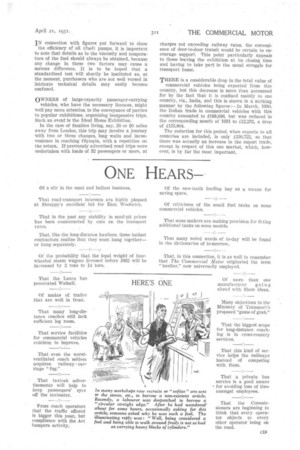LOOSE LEAVES
Page 40

Page 41

If you've noticed an error in this article please click here to report it so we can fix it.
ACOMMON fault in connection with inspection pits is their shallowness. This causes considerable waste of time when handling modern vehicles with low-level frames. An interesting example of correct construction is to be seen at the new Tecalemit headquarters on the Great West Road. The depth of each pit allows a 6-ft. mechanic to work in comfort, whilst the sides of the pit are inclined so that there are openings outside the runways for the wheels, thus permitting light to enter. Glazed tiles line the pit and act as light reflectors. Such an installation must save a good deal of money in the course of a year.
ACCORDING to a report, in America taxicab travel is more popular than is railway transport. It is stated that passengers are being carried in taxicabs at the amazing rate of 1,000,000,000 per year, whereas in 1929 (the latest year for which statistics are available) the railways carried 786,000,000 persons.
In New York City alone it is estimated that last year the taxis carried. altogether. 380,000,000 passengers, the gross earnings approximating 3l,400,000.
c18 A FREQUENT cause of trouble, and one that is not so generally well known as might be thought, is the distortion of pistons, both aluminium and cast iron, through the removal and insertion of gudgeon pins.
The body of a modern piston is often so thin that any expansion or contraction of the comparatively large masses holding the gudgeon pin may cause serious warping. This is particularly the case if the piston be warmed by dropping into hot water to enable a tight gudgeon pin to be driven out or refitted. In almost every instance the trouble can be completely overcome by giving the piston a few sharp taps with a wood hammer or hammer handle Just before it is returned to the cylinder.
A PERUSAL of the S.A.E. Journal of America leaves no doubt that automobile engineers on the other side of the Atlantic are getting very busy on the compression-ignition engine. Generally speaking, they seem to have reached the same results as engineers in this country, but data as to longevity and maintenance are not very comprehensive; although we in this country have a greater experience of oil engines than they in the States, the same Information is urgently sought by prospective users. IN connection with figures put forward to show
the efficiency of oil (fuel) pumps, it is important to note that details as to the viscosity and temperature of the fuel should always be obtained, because any change in these two factors may cause a serious difference. It is to be hoped that a standardized test will shortly be instituted as, at the moment, purchasers who are not well versed in intricate technical details may easily become confused.
OWNERS of large-capacity passenger-carrying vehicles, who have the necessary licences, might well pay more attention to the conveyance of parties to popular exhibitions, organizing inexpensive trips. Such an event is the Ideal Home Exhibition.
In the case of families living, say, 20 or 30 miles away from London, this trip may involve a journey with two or three changes, long waits and inconvenience in reaching Olympia, with a repetition on the return. If previously advertised road trips were undertaken with loads of 32 passengers or more, at charges not exceeding railway rates, the convenience of door-to-door transit would be certain to encourage support. This point particularly appeals to those leaving the exhibition at its closing time and having to take part in the usual struggle for transport home.
THERE is a considerable drop in the total value of commercial vehicles being exported from this country, but this decrease is more than accounted for by the fact that it is confined mainly to one country, viz., India, and this is shown in a striking manner by the following figures :—In March, 1930, the Indian trade in commercial vehicles with this country amounted to 1108,036, but was reduced in the corresponding month of 1931 to 112,232, a drop of £155,804.
The reduction for this period, when exports to all countries are included, i8 only £130,722, so that there was actually an increase in the export trade, except in respect of this one market, which, however, is by far the most important,












































































































